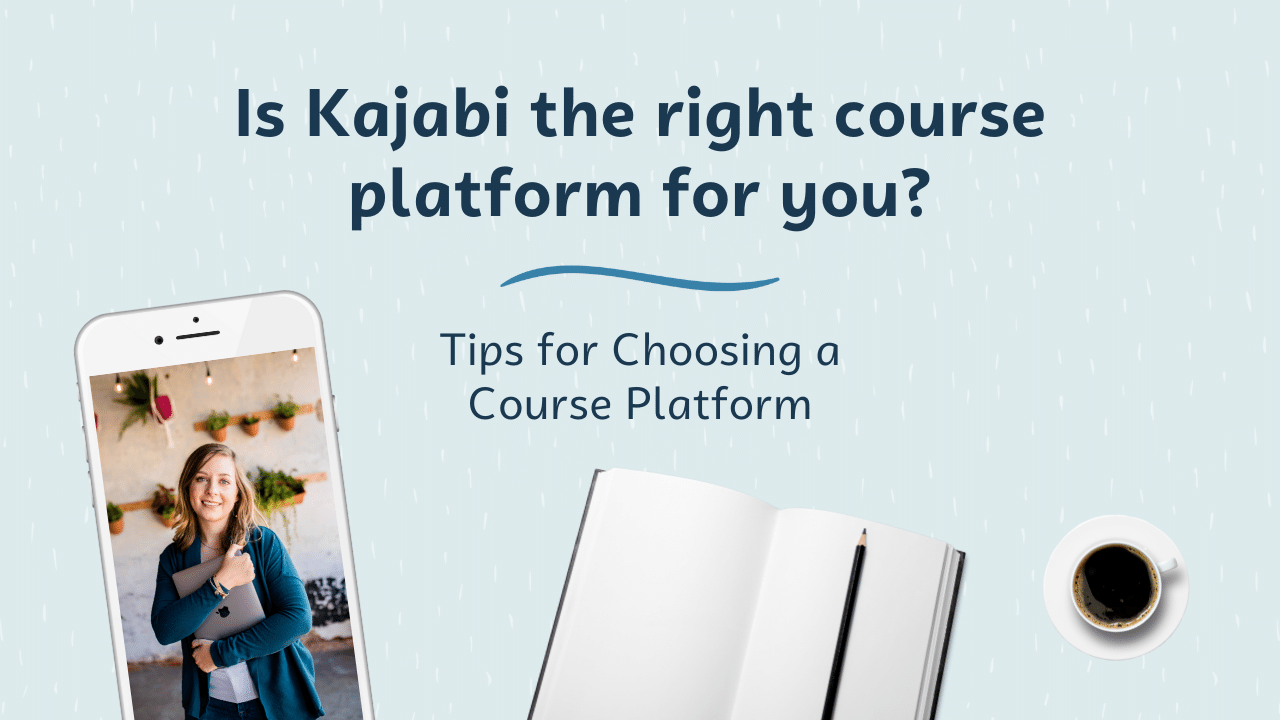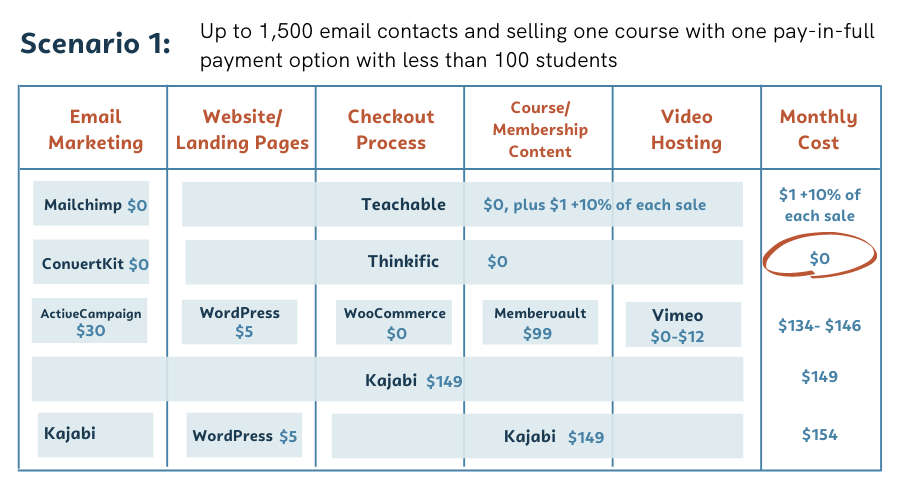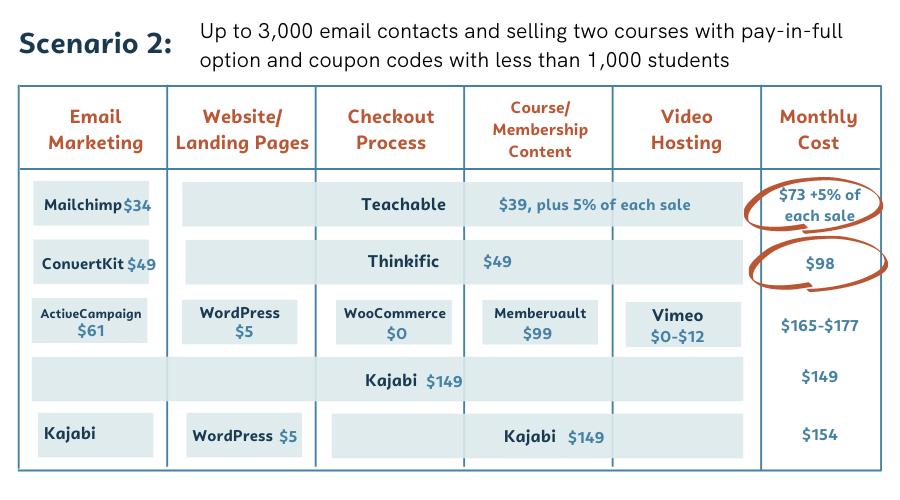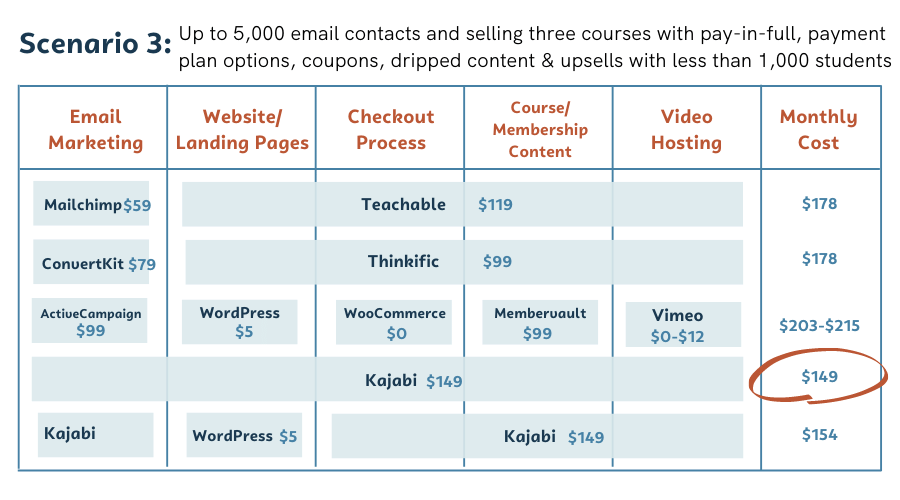Is Kajabi the right course or membership platform for you?
Jul 05, 2022
Every single day (and that’s not an exaggeration) I see posts in different Facebook groups asking for opinions on which course platform to use. What about Kajabi? Or Thinkific? Or Teachable?
I know that making the decision on which platform to use can be so overwhelming AND the thing that literally stops you in your tracks from moving forward.
So, before we dive deeper into the question of whether Kajabi is the right platform for you, I want to let you in on a little secret.
There is no perfect platform out there.
What’s more important than the platform itself is the act of just choosing one and moving forward!
I’m going to say it again: There is NOT a perfect platform out there. So, if you’ve spent hours upon hours researching and trying to find the perfect one, it doesn’t exist. (But in my opinion, Kajabi is pretty darn close to perfect and I think it is a winning option!)
Just remember: without a solid, irresistible offer that you audience is craving, you could have the best platform in the world and still not see success.
What kinds of software do I need to sell courses?
First, I want to explain what functions your platform(s) need to offer in order to market and sell online courses and memberships. You will need one or more platforms to perform the following functions. I’ve included some examples of standalone platforms for each function.
✉️Email Marketing - This is how you will communicate with your audience of prospective buyers and students after they join your program.
Examples: ConvertKit, ActiveCampaign, Mailchimp, Constant Contact, Flodesk
🌐Website/Landing Pages - This is where you will build a sales page to be able to send traffic to so they can learn all about your program.
Examples: WordPress, Leadpages, Sqaurespace
🛒Checkout Process - This is how your prospective buyers will actually purchase your program so they can get access to the content.
Examples: WooCommerce, ThriveCart
🎬Course/Membership Content - This is where all of your content (videos, PDFs, lesson text, links, other downloadable files will all live for your students to learn from.
Examples: Thinkific, Teachable
📹Video Hosting - Many course/membership platforms will also include video hosting as part of their platform, but if they do not you will need a separate platform for your videos to “live.”
Examples: Vimeo, Wistia
🔗Linking Separate Platforms Together - If you use multiple platforms, you might a separate software to allow them to communicate so that when someone makes a purchase, they are added to your email list and given access to the course materials.
Examples: Zapier, Pabbly
Multiple platforms or an all-in-one platform?
When it comes to selling online courses, you have two options:
- Pay for multiple platforms that each specialize in one or two of the functions above and integrate them together
- Pay for an all-in-one platform (like Kajabi) that performs all the functions listed above
The main benefit to an all-in-one platform is that you only have one platform to learn and you can avoid some of the tech hiccups that occur when the communication between different platforms breaks down. However, compared to a completely-custom WordPress course, there will be fewer customization options. (Personally, I think that can be a great thing since too many options can lead to inaction.)
If you do decide to go with an all-in-one platform, that also doesn't mean you can't still continue to use additional platforms in conjunction if you choose. One common scenario is when people who purchase Kajabi already have full websites and blog posts on WordPress, so they continue to run their website on WordPress. It's much less of a hassle for them to keep everything there (especially with all of the SEO they have built up over time) and use Kajabi for the rest.
Here are some examples of just some of the different combinations people use for all the tech needed to sell online courses and memberships:

Course Platform Features
Ok, so let’s dive into if Kajabi is actually a great fit for your needs!
This blog post isn’t going to compare and contrast every single possible platform out there (as that would be impossible to do!) but it will give you a few key things you need to consider to help determine if you should start up your Kajabi subscription. As you are researching different course platforms, I highly suggest going to the website for each one and looking at the different features included on each plan. If there are features you know you want to have, make sure to see if they are included. This can be one really helpful way to narrow down which platform you ultimately decide to use.
Here are just some of the features that you may want to think about how important they are to you for the platform to offer:
- Number of students you can have
- Number of courses/products you can create
- The ability to drip out content (i.e. release new videos/PDFs daily or weekly after someone purchases)
- The ability to charge a pay-in-full price and a payment plan price
- The ability to charge recurring subscription payments
- The ability to use Zapier to connect platforms together (sometimes requires a certain paid plan to use Zapier)
- The ability to add your own custom domain
- Built-in community feature (similar to a Facebook group)
- Built-in quizzes/assessments for students to take
- Automated emails to students
- If any additional transaction fees get taken out besides PayPal/Stripe/Payment Processor fees
As you research different platforms, you may see features listed that you hadn’t even thought about before. My biggest piece of advice would be to truly think about what features are *completely necessary* for your needs and which are just “nice-to-haves.” That way, you can narrow down which platforms truly meet your needs.
Key Considerations
Now we’re going to look at a few key questions you need to consider to help you determine whether Kajabi is the right platform for you. For this blog post, I’m primarily talking to course and membership creators that are in the beginning stages with choosing their first course delivery platform. With that in mind, they are wanting to get the most “bang for their buck” where they can get the features they need while balancing the cost they are paying.
Consideration #1: What types of products and how many products are you planning on selling?
If you're primarily selling physical products, then Kajabi isn't going to be the best fit for you. But if you're selling digital products, it will work perfectly for that.
On the basic plan, Kajabi allows you to have up to three products (i.e. courses or memberships.)
Consideration #2: What other platforms are you already using?
If you are brand new to online business and don't yet have an email marketing system or website, Kajabi is an easy choice that can meet all those needs.
If you already have a website and email marketing system, you can continue to use them and integrate them with Kajabi and only use Kajabi for the actual course delivery.
Consideration #3: Are you the type of person that values simplicity or endless options more?
If you crave simplicity in your business and prefer to only have to learn to navigate one platform instead of many, then an all-in-one platform like Kajabi could be a great fit.
On the other hand, one of the tradeoffs of an all-in-one platform is that there are usually not quite as many customization options as you would have by linking together multiple platforms that each specialize in one thing. If you like learning new platforms and want to have endless customization options available, then choosing separate platforms for email marketing, your website and sales pages, your checkout/cart, and your course delivery might be a better fit for you.
Consideration #4: How tech savvy are you?
If tech doesn't come quite as naturally to you, choosing an all-in-one platform like Kajabi that is specifically built for anyone to be able to use easily might be a better choice. Since it is an all-in-one, that also means spending time learning one platform instead of many.
If you know you want to start with a platform that can serve you for the long term where you won't have to migrate everything to a new platform later on, Kajabi can also be a great option.
Consideration #5: How much revenue do you currently have coming into your business?
This one is a key one to think about! If you do not have any money coming into your business yet, it might be a wiser choice to bootstrap your systems with free options to begin. This can take more work on your end in the beginning, but might be a worthwhile tradeoff until you can afford a platform like Kajabi.
However, once you have revenue coming in, then the ease of having everything in one place can actually make the cost absolutely worth it in the time that you save and the seamless experience you can provide to your students.
If you ask yourself these five questions, you can get a much clearer picture of what the best option is for you. I know it’s not always an easy decision, especially when you’re paying to use one or multiple platforms on a monthly or yearly basis and you want to make the best financially sound business decision.
So, is Kajabi really more expensive than other course platforms?
It really depends on your unique situation. If you use a separate email marketing platform, as your number of subscribers increases, typically your monthly cost does, too. Same for your course platform - as the number of students increases, sometimes the cost does, too. You can typically start off on a free plan of some course platforms, but you’ll often be limited in how many courses you can have and what extra features you have access to, like offering payment plans to your students, coupon codes, dripping out your content, or adding upsells to your checkout.
Here are a few scenarios comparing the cost of different platforms:



These different scenarios show that it really depends on what features you would like to have. If you are starting off by selling one course with one pricing option that they will get full access to when they purchase, you can definitely start with a course platform that is inexpensive and fits those needs. As your number of subscribers grows and you want to have more features in your course platform, you may have to start paying more. Or, if you decide that you want to pay more in the beginning so that you don’t have to move everything from one platform to another later on (which can be a major pain), you can choose something like Kajabi that can be more expensive at first, but is actually one of the cheaper options in the long run.
Is Kajabi the right course platform for you? Take the Quiz!
I’ve taken these different considerations and created a 14 question quiz to help you determine if Kajabi is the right choice for you. I hope it helps to reduce some of the overwhelm as you’re searching for the right course platform.
Questions? Still feeling overwhelmed? I’d love to hear from you! Just email me at [email protected]
Interested in learning more about how you can get your Kajabi course or membership set up in one day?
New to Kajabi? Grab my Get Started Quick Guide to get all your site settings in place first!
Enter your name and email to get it delivered straight to your inbox!
We hate SPAM. We will never sell your information, for any reason.


